Citation: Yu-Huei Cheng, Ching-Ming Lai, Jiashen Teh. Genetic algorithm with small population size for search feasible control parameters for parallel hybrid electric vehicles[J]. AIMS Energy, 2017, 5(6): 930-943. doi: 10.3934/energy.2017.6.930
| [1] | Ahmed Neffati, Amira Marzouki . Local energy management in hybrid electrical vehicle via Fuzzy rules system. AIMS Energy, 2020, 8(3): 421-437. doi: 10.3934/energy.2020.3.421 |
| [2] | Hideki Kato, Ryosuke Ando, Yoshinori Kondo, Tsutomu Suzuki, Keisuke Matsuhashi, Shinji Kobayashi . The eco-driving effect of electric vehicles compared to conventional gasoline vehicles. AIMS Energy, 2016, 4(6): 804-816. doi: 10.3934/energy.2016.6.804 |
| [3] | Samson Obu Showers, Atanda Kamoru Raji . State-of-the-art review of fuel cell hybrid electric vehicle energy management systems. AIMS Energy, 2022, 10(3): 458-485. doi: 10.3934/energy.2022023 |
| [4] | K. M. S. Y. Konara, M. L. Kolhe, Arvind Sharma . Power dispatching techniques as a finite state machine for a standalone photovoltaic system with a hybrid energy storage. AIMS Energy, 2020, 8(2): 214-230. doi: 10.3934/energy.2020.2.214 |
| [5] | Edwin Collado, Easton Li Xu, Hang Li, Shuguang Cui . Profit maximization with customer satisfaction control for electric vehicle charging in smart grids. AIMS Energy, 2017, 5(3): 529-556. doi: 10.3934/energy.2017.3.529 |
| [6] | Md. Arman Arefin, Avijit Mallik . Numerical investigation of solar and wind energy assisted plugged in hybridized engine driven auto-rickshaw/three-wheeler. AIMS Energy, 2018, 6(2): 358-375. doi: 10.3934/energy.2018.2.358 |
| [7] | Mansoor Soomro, Zeeshan Ali Shaikh, Mazhar Baloch, Abdul Manan Shaikh, Sohaib Tahir Chauhdary . Development of wind and solar systems for power charging: An application of an electric vehicle to grid systems. AIMS Energy, 2024, 12(3): 664-685. doi: 10.3934/energy.2024031 |
| [8] | Surender Reddy Salkuti . Sustainable energy technologies for emerging renewable energy and electric vehicles. AIMS Energy, 2024, 12(6): 1264-1270. doi: 10.3934/energy.2024057 |
| [9] | Steven B. Sherman, Zachary P. Cano, Michael Fowler, Zhongwei Chen . Range-extending Zinc-air battery for electric vehicle. AIMS Energy, 2018, 6(1): 121-145. doi: 10.3934/energy.2018.1.121 |
| [10] | Carla Viveiros, Rui Melicio, Victor Mendes, Jose Igreja . Adaptive and predictive controllers applied to onshore wind energy conversion system. AIMS Energy, 2018, 6(4): 615-631. doi: 10.3934/energy.2018.4.615 |
The development of environmental friendly vehicles with low to no fuel consumption is increasingly important in the automotive industry. In particular, hybrid electric vehicles (HEVs) have received the most attentions. Having good fuel economy, HEVs also produce few carbon emissions, and for this reason, they are widely accepted by environmentalists. It is expected that HEVs will become the model of future vehicles due to global energy crises and global warming.
In a typical HEV, there are two energy converters—internal combustion engine (ICE) and electric motor (EM), which complicate energy flows as the conventional vehicles have only ICE. Due to this, an appropriately designed HEV control strategy that incorporates both the ICE and EM is essential. Thus far, several control strategies have been proposed and they have all been proven to improve fuel consumptions and lower engine emissions [1,2,3,4,5,6].
At the same time, the evolutionary computation methods have received considerable interest as well and they have been applied in various fields, which include, biomedical primer design [7,8,9,10,11,12], feature selections [13], non-dominated sorting [14], image processing [15], unmanned aerial vehicles (UAVs) path planning [16], wireless sensor networks [17], constructal-design work [18,19], and most importantly, HEV control strategy. Within the field of HEV control strategy and evolutionary computation, Montazeri and Poursamad have presented a genetic algorithm (GA) to minimize fuel consumption (FC) and engine emissions [20]. In it, the vehicle dynamic performance requirements as stipulated in the Partnership for a New Generation of Vehicles (PNGV) [21] was considered. In 2008, the particle swarm optimization (PSO) was proposed by Wu et al. as the search algorithm for determining optimal parameters and control strategies of powertrains for reducing FC, engine emissions and the manufacturing costs of HEVs [22]. In 2012, the Bee Algorithm (BA) was applied by Long and Nhan to minimize FC and engine emissions [23]. They also considered the PNGV constraints when determining the vehicle performance. In 2017, the Memetic Algorithm (MA) was proposed by Cheng and Lai for solving highly non-linear problems and discontinuous powertrain systems that contain several local optima. The MA is also useful for obtaining better control parameters in parallel HEVs [24]. All the aforementioned studies demonstrate that appropriate control strategies and parameters are able to reduce both the fuel consumptions and engine emissions of HEVs without sacrificing the driving performance of the vehicles. For this reason, the search for feasible control parameters is a continuous effort in the designing of HEVs.
Notwithstanding the efforts of the cited studies above, one major drawback of evolutionary algorithms is that their algorithmic parameters are difficult to be determined. This is important as inappropriate parameters can cause premature convergence of the algorithms, consequently leading to inaccurate results and time wastage as unnecessary computations are performed. In order to overcome this drawback, we propose a genetic algorithm (GA) with small population size when searching for feasible parameters in parallel HEVs control strategy. In this paper, the GAs with different five small population sizes have been implemented. The implemented GAs aim to minimize engine fuel consumptions and emissions, while maintaining the required parallel HEVs road performance. The fundamental control mechanisms of our proposed parallel HEVs are based on the electric assist control strategy (EACS) [25]. As for the dynamic performance requirements of the parallel HEVs, the criteria stipulated in the PNGV is used. The known ADvanced VehIcle SimulatOR (ADVISOR) was used to simulate the parallel HEV with the urban dynamometer driving schedule (UDDS) for estimating the performance of the proposed GA with small population size.
Figure 1 shows the structure and dynamic model of a parallel HEV. The figure shows that the parallel HEV is powered by the fuel converter/ICE and the electric motor. The battery can be charged by absorbing the excess power of the fuel converter or by the regenerative brake action of the electric motor. The power of the fuel converter through clutch is transmitted to the torque coupler by a switch. On the other hand, the power of the electric motor is directly transmitted to the torque coupler. Finally, the gearbox converts the high-speed and low-torque mechanical power, generated by either the fuel converter or electric motor, into a more efficient low-speed and high-torque power to drive the HEV.
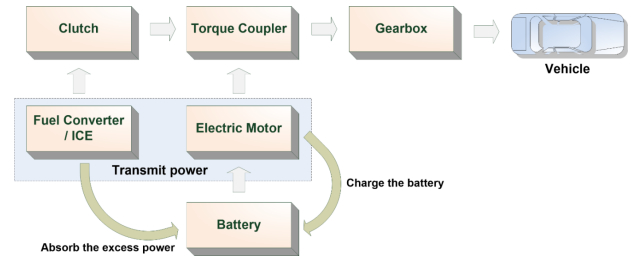 Figure 1. The structure and dynamic model of the parallel HEV.
Figure 1. The structure and dynamic model of the parallel HEV.The electric assist control strategy (EACS) is a commonly used strategy for the control of HEVs [20]. Therefore, eight independent parameters of EACS are used as the fundamental control strategy of parallel HEVs [24]. These parameters are considered by the proposed GA in order to reduce engine fuel consumption and emissions, while maintaining the required performance of parallel HEVs. The employed parameters of EACS in this paper is given in Table 1.
| Parameter | Description |
| SOCL | The lowest state of charge allowed. |
| SOCH | The highest state of charge allowed. |
| Tch | An alternator-like torque loading on the engine to recharge the battery pack. |
| Tmin | Minimum torque threshold on SOC < SOCL. During low torque, the engine will be manipulated at the threshold torque (minimum torque threshold = Tmin × Tmax). Additionally, if SOC < SOCL, the electric motor serves as a generator. |
| Toff | Minimum torque threshold on SOC > SOCL. During low torque and if SOC > SOCL, the engine will be shut down (minimum torque threshold = Toff × Tmax). |
| ELSL | The lowest vehicle speed threshold. |
| ELSH | The highest vehicle speed threshold. |
| Dch | To use charge deplete strategy or charge sustaining strategy. |
In the EACS, the electric motor is employed based on the following six conditions:
(1) SOC of the battery is more than its SOCL and the required speed is less than ELS. The engine is switched off. (Figure 2, Case 1).
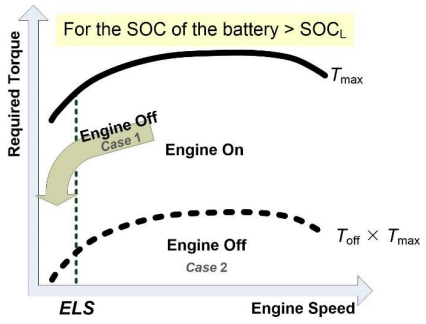 Figure 2. The SOC of a battery is more than SOCL.
Figure 2. The SOC of a battery is more than SOCL.(2) The required torque is less than the minimum torque threshold (Toff × Tmax). The engine is switched off (Figure 2, Case 2).
(3) The engine is switched off (Figure 2, Case 1 and Case 2, and Figure 3, Case 1). The motor provides the total required torque.
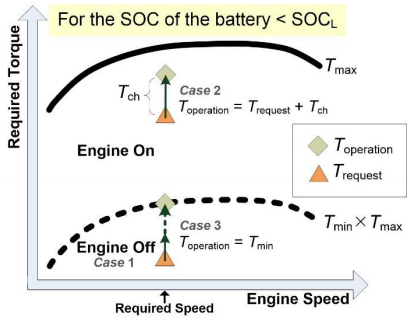 Figure 3. The SOC of a battery is less than SOCL.
Figure 3. The SOC of a battery is less than SOCL.(4) SOC of the battery is less than its SOCL. An alternator-like torque (Tch) is derived from the engine to charge the battery (Figure 3, Case 2).
(5) The engine charging torque is applied when the engine is started (Figure 3, Case 2).
(6) The engine torque is maintained at the minimum torque threshold (Tmin × Tmax) (Figure 3, Case 3) in order to avoid the engine from operating in low torque condition.
The Partnership for a New Generation of Vehicles (PNGV) [21] is a collaborative research program between the US government and major car companies, with the aim of commercializing highly fuel-efficient vehicles (up to 80 mpg) by 2003 [26]. The criteria of fuel-efficient vehicles as listed in the PNGV report is used as the dynamic performance requirements to maintain the road performance of the proposed HEV. The seven identified PNGV criteria are listed in Table 2.
| Parameter | Description |
| Acceleration time 1 | 0–60 mph in 12 s |
| Acceleration time 2 | 40–60 mph in 5.3 s |
| Acceleration time 3 | 0–85 mph in 23.4 s |
| Maximum speed | ≥90 ft/s |
| Maximum acceleration | ≥17 ft/s2 |
| Distance in 5 s | ≥140 ft |
| Gradeability | 6.5% gradeability at 55 mph with 272 kg additional weight for 20 min |
The flowchart of the proposed GA with small population size for searching feasible parameters of control strategy for parallel HEVs is shown in Figure 4. The flowchart can be categorized into five processes: (1) chromosome encoding, (2) small population size initialization, (3) population fitness evaluation, (4) termination judgment, and (5) evolutionary operations of the GA. They are described below.
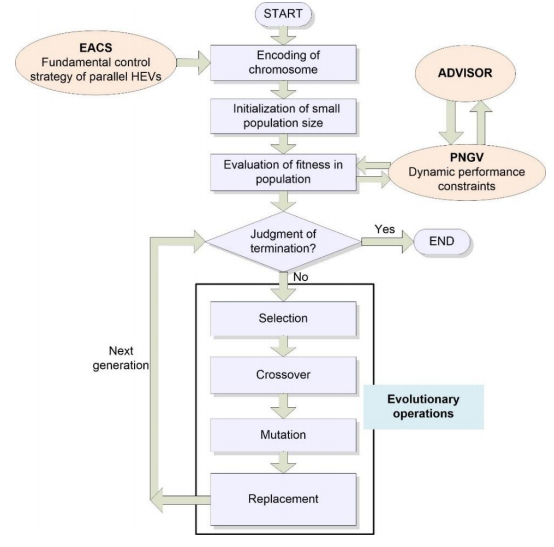 Figure 4. The proposed GA with small population size for searching feasible parameters of control strategy for parallel HEVs.
Figure 4. The proposed GA with small population size for searching feasible parameters of control strategy for parallel HEVs.(1) Chromosome encoding
The chromosome encoding process used in the proposed GA is based on the eight independent EACS parameters as given in Table 1. Therefore, each x chromosome is represented with eight genes as shown in (1).
| x=(SOCL,SOCH,Tch,Tmin,Toff,ELSL,ELSH,Dch) | (1) |
(2) Small population size initialization
Considering the performance efficiency of the ADVISOR program, the proposed GA is conducted in small population size. The initial population of the chromosomes based on (1) is randomly generated and it is limited by a predetermined small population size.
(3) Population fitness evaluation
The fitness, also known as the objective function, of the population, is defined through a simple aggregation function as given by (2). The objective function accumulates and minimizes the fuel consumptions and engine emissions, which are made up of HC, CO and NOx.
| Objective(x)=FC+HC+CO+NOx | (2) |
where x is a chromosome; FC is fuel consumption; HC is hydrocarbons, CO is carbon monoxide, and NOx is nitrogen oxides.
In addition, the penalty functions are also considered in order to maintain vehicle performance requirements. The penalty functions are based on the above seven the dynamic performance constraints of PNGV as shown in Table 2. When the vehicle performance satisfied the dynamic performance constraints of the PNGV, the penalty value is 0. However, when the vehicle performance is worse than the dynamic performance constraints of the PNGV, the absolute value of the difference between the value of the vehicle performance and the value of the dynamic performance constraints of the PNGV will be assigned as the penalty value.
Finally, the fitness function is determined by (3). It is adapted to evaluate chromosomes' fitness based on the known ADvanced VehIcle SimulatOR (ADVISOR).
| fitness(x)=1/[Objective(x)+∑7i=1yi×pi(x)] | (3) |
where Yi is a penalty factor, which is determined by the considered performance in the dynamic performance constraints of PNGV. In this study, the penalty factors are set as 1.2, 1.5, 1.2, 1.2, 1.2, 1.2, and 2.0 for the seven dynamic performance constraints of the PNGV [23]; pi(x) is a penalty function.
(4) Termination judgment
In this paper, the proposed GA is terminated when the predetermined number of generations has been reached. In general, the GAs with larger number of generations has better performance results than the GAs with lesser number of generations. However, the GAs with the smaller number of generations can be performed more efficiently.
(5) Evolutionary operations
Evolutionary operations such as selection, crossover, mutation, and replacement are implemented in the proposed GA. First of all, the selection operation randomly selects two chromosomes from the population and this is followed by the crossover operation. If the generated random number is larger than the probability for crossover, the selected two chromosomes randomly exchange their genes to produce two new offspring. Then, mutation is considered. If the generated random number is larger than the probability for mutation, one of the two new offspring is selected and it undergoes random alteration of its genes in order to produce a new offspring. Finally, the replacement operation is carried out. During the operation, the least fit chromosomes will be replaced by the new chromosomes. The evolutionary operations are repeated until the termination criteria is achieved.
The user-defined parameters of the proposed GA are population size, the number of generations, the probability of crossover, and the probability of mutation. In this paper, we only consider five small population sizes of 5, 10, 15, 20, and 25. The number of generations is set to 500. The probability of crossover is set to 1.0 in order for avoid invalid generation. The probability of mutation is set to 0.1 in order to achieve 10% probability of escaping local optimum.
The urban dynamometer driving schedule (UDDS) is used for estimating the benefit of the selected parameters of control strategy. In this study, the known ADvanced VehIcle SimulatOR (ADVISOR) is used to simulate the fuel consumptions and engine emissions of parallel HEVs in UDDS and to provide the results for fitness evaluation.
The search results for feasible parameters of control strategy based on five small population sizes are shown in Table 3. From Table 3, we can observe that when the population size is 25, the proposed GA produce the highest fitness value. Furthermore, the average evolutionary fitness for the population sizes of 5, 10, 15, 20, and 25 are shown in Figure 5–Figure 9, respectively.
| Parameter | Population size | ||||
| 5 | 10 | 15 | 20 | 25 | |
| SOCL | 0.43 | 0.34 | 0.05 | 0.20 | 0.38 |
| SOCH | 0.86 | 0.85 | 0.95 | 0.98 | 0.95 |
| Tch | 60.20 | 12.00 | 4.40 | 3.60 | 1.00 |
| Tmin | 0.74 | 0.28 | 0.27 | 0.93 | 0.12 |
| Toff | 0.66 | 0.69 | 0.98 | 0.09 | 0.77 |
| ELSL | 3.00 | 4.00 | 12.00 | 10.00 | 13.00 |
| ELSH | 16.00 | 23.00 | 10.00 | 13.00 | 28.00 |
| Dch | 1 | 1 | 1 | 1 | 1 |
| Fitness value | 0.258 | 0.246 | 0.239 | 0.245 | 0.264 |
 Figure 5. The average evolutionary fitness for the population size of 5.
Figure 5. The average evolutionary fitness for the population size of 5.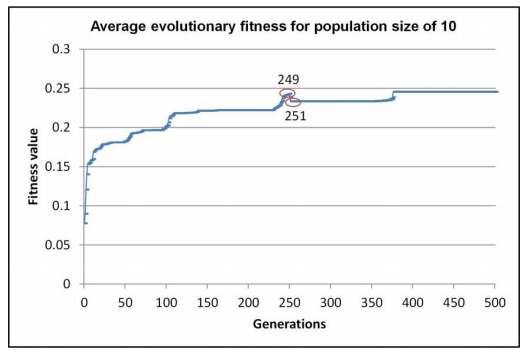 Figure 6. The average evolutionary fitness for the population size of 10.
Figure 6. The average evolutionary fitness for the population size of 10.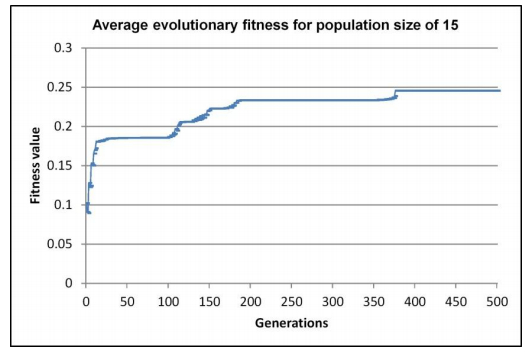 Figure 7. The average evolutionary fitness for the population size of 15.
Figure 7. The average evolutionary fitness for the population size of 15.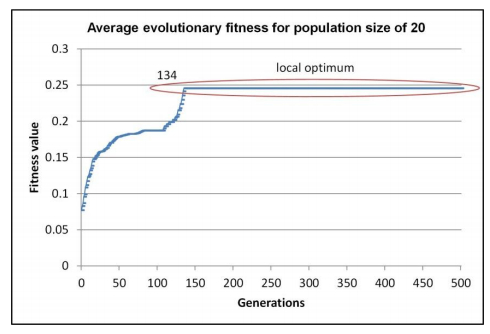 Figure 8. The average evolutionary fitness for the population size of 20.
Figure 8. The average evolutionary fitness for the population size of 20.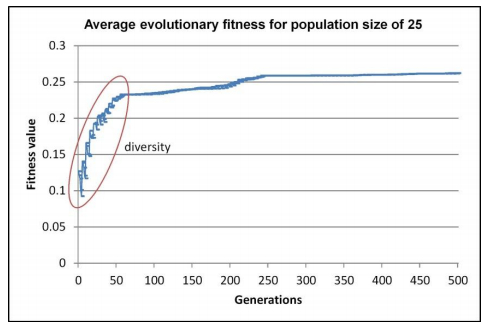 Figure 9. The average evolutionary fitness for the population size of 25.
Figure 9. The average evolutionary fitness for the population size of 25.Figure 5 shows the result of the proposed GA with a population size of 5. It is observed that the fitness value increases dramatically from about 0.14 at 0 number of generations to about 0.26 at 124 number of generations. In between 126 and 250 number of generations, the observed improvement in the fitness value is insignificant. The same can observed as well between 251 and 500 number of generations. Notice that when the number of generations were increased from 124 to 125, the average fitness value decreases and it continues to drop despite the number of generations was further increased to 126. This similar trend can also be observed when the number of generations was increased from 250 to 251. The reason for the degrading of fitness values is due to the mutation operation and this shows that the average fitness is easily influenced by the mutation operation when the population size is too small, as in this case.
In Figure 6, the population size is set to 10. The result shows that the average fitness value gradually improves as the number of generations increases, except when the number of generations increases from 249 to 251. Analysis of the result also demonstrates that the influence of the mutation operation has been reduced as the population size increases.
In Figure 7, the population size is set to 15. Similarly to Figure 6, the result in this figure shows that the average fitness value improves gradually. The influence of the mutation operation has also been eliminated.
In Figure 8, the population size is set to 20. Up to until before 134 number of generations, the average fitness value improves gradually. After that, the average fitness value can no longer be improved and this signifies that the proposed GA has fallen into a local optima search.
In Figure 9, the number of population size is set to 25. It is observed that the average fitness value continues to improve up to until the maximum number of generations 500. This is widely due to the diversity of the fitness values that can be observed in the initial generations, which contributed to better solutions in the later generations.
The results for FC and emissions using the above feasible parameters of control strategy are shown in Table 4. From Table 4, we can conclude that when the population size is set to 25, the FC is the most economical at 0.0296 gal/mi. Furthermore, the emissions of HC, CO, and NOx have the lowest values at 0.577, 2.886, and 0.460 g/mi, respectively. On the other hand, when the population size is set to 5, the FC is the second most economical at 0.0312 gal/mi. However, the emissions of HC and CO are the second highest at 0.614 and 5.373 g/mi, respectively, and the emission of NOx is the highest at 0.539 g/mi. When the population size is set to 10 and 15, the values of FC and the emissions of HC, CO, and NOx are in between the results obtained by the population size of 5 and 25. When the population size is set to 20, the FC is the most uneconomical at 0.0356 gal/mi. Furthermore, the emissions of HC and CO are the highest at 0.651 and 10.809 g/mi, respectively. Therefore, the population size of 25 is the best among the five small population sizes that have been investigated for searching feasible parameters of the control strategy for reducing the FC and engine emissions.
| Parameter | Population size | ||||
| 5 | 10 | 15 | 20 | 25 | |
| FC (gal/mi) | 0.0312 | 0.0320 | 0.0319 | 0.0356 | 0.0296 |
| HC (g/mi) | 0.614 | 0.609 | 0.598 | 0.651 | 0.577 |
| CO (g/mi) | 5.373 | 4.314 | 3.059 | 10.809 | 2.886 |
| NOx (g/mi) | 0.539 | 0.547 | 0.491 | 0.536 | 0.460 |
The results for dynamic performance based on five small population sizes are shown in Table 5. From the table, we can observe that all the obtained results satisfy to the seven dynamic performance constraints of PNGV as shown in Table 2 except the maximum acceleration parameter. The case with 25 number of population outperforms all other population sizes in six out of the seven compared parameters. The remaining parameter—maximum acceleration, registers similar performance across all population sizes.
| Parameter | Population size | ||||
| 5 | 10 | 15 | 20 | 25 | |
| 0–60 mph (s) | 9.089 | 9.344 | 10.112 | 9.387 | 9.011 |
| 40–60 mph (s) | 4.537 | 4.719 | 5.234 | 4.746 | 4.490 |
| 0–85 mph (s) | 18.442 | 19.237 | 21.454 | 19.348 | 18.234 |
| Maximum speed (ft/s) | 118.644 | 116.425 | 111.930 | 116.204 | 119.511 |
| Maximum acceleration (ft/s2) | 16.243 | 16.243 | 16.243 | 16.243 | 16.243 |
| Distance in 5 seconds (ft) | 179.567 | 178.515 | 174.876 | 178.213 | 180.195 |
| Gradeability (%) | 6.5 | 6.5 | 6.5 | 6.5 | 6.5 |
The execution time of the investigated five population sizes are compared and it is shown in Figure 10. The population size that is set to 20 has the fastest execution time and it was completed in 17.55 hours. Contrary, the population size that is set to 15 is the slowest with an execution time of 19.75 hours. Despite the setting with the population size of 20 performed the fastest, its fitness value is not among the best. The reason is due it being trapped in the local optima search that no longer improves fitness value and, thus, prematurely ending the simulation, as can be observed in Figure 8. When the population size is 25, the execution time is faster than the population sizes of 5 and 15, but worse than the population size of 10. Nonetheless, the population size of 25 has the highest fitness value. This shows that the execution time is not the essential evaluation criteria for determining the feasible parameters of control strategy for parallel HEVs. Hence, the population size of 25 is still considered as the best algorithmic parameter among the five small population sizes that have been considered.
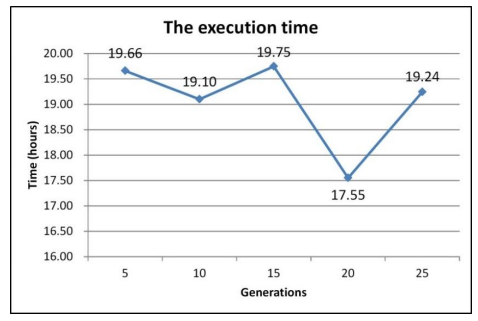 Figure 10. The execution time for the population sizes of 5, 10, 15, 20, and 25.
Figure 10. The execution time for the population sizes of 5, 10, 15, 20, and 25.A GA with small population size is proposed in this study for providing feasible parameters of the control strategy for reducing the engine fuel consumption and emissions, while maintaining vehicle performance requirements in parallel HEVs. The EACS is used as the fundamental control strategy of parallel HEVs and the PNGV is used as the dynamic performance requirements to maintain the vehicle performance. Furthermore, the ADVISOR is used to simulate the parallel HEV based on UDDS. Five small population sizes of 5, 10, 15, 20, and 25 have been evaluated to compare their search ability for feasible parameters of the control strategy. Results show that the small population size of 25 has the best results with the highest fitness value at 0.264. Its FC, engine emissions and the dynamic performance are all better than other small population sizes. The feasible parameters of SOCL, SOCH, Tch, Tmin, Toff, ELSL, ELSH, and Dch of the control strategy was obtained at 0.38, 0.95, 1.00, 0.12, 0.77, 13.00, 28.00, and 1, respectively. The main contributions of this paper is the proposal of a small population size of GA for searching feasible control parameters to improve fuel saving and minimize engine emissions while maintaining the performance of the parallel HEVs. In the future, other advanced evolutionary methods will be compared with the proposed method in this paper. Furthermore, the conventional GA with large population size will also be compared with the proposed GA with small population size. Finally, other driving cycles will also be studied.
The authors would like to thank the funding support given by the USM short term grant: PELECT/304/60313051, the Ministry of Science and Technology (MOST) in Taiwan under grant MOST106-2218-E-027-010, and the Chaoyang University of Technology in Taiwan under grant CYUT-106-7778.
All authors declare no conflicts of interest in this paper.
| [1] |
Baumann BM, Washington G, Glenn BC, et al. (2000) Mechatronic design and control of hybrid electric vehicles. IEEE-ASME T Mech 5: 58–72. doi: 10.1109/3516.828590

|
| [2] |
Lin CC, Peng H, Grizzle JW, et al. (2003) Power management strategy for a parallel hybrid electric truck. IEEE T Contr Syst T 11: 839–849. doi: 10.1109/TCST.2003.815606

|
| [3] |
Pisu P, Rizzoni G (2007) A comparative study of supervisory control strategies for hybrid electric vehicles. IEEE T Contr Syst T 15: 506–518. doi: 10.1109/TCST.2007.894649

|
| [4] |
Salmasi FR (2007) Control strategies for hybrid electric vehicles: evolution, classification, comparison, and future trends. IEEE T Veh Technol 56: 2393–2404. doi: 10.1109/TVT.2007.899933

|
| [5] |
Yu H, Kuang M, McGee R (2014) Trip-oriented energy management control strategy for plug-in hybrid electric vehicles. IEEE T Contr Syst T 22: 1323–1336. doi: 10.1109/TCST.2013.2278684

|
| [6] | Panday A, Bansal HO (2016) Energy management strategy implementation for hybrid electric vehicles using genetic algorithm tuned pontryagin's minimum principle controller. Int J Veh Technol 2016: 1–13. |
| [7] |
Cheng YH (2014) Computational intelligence-based polymerase chain reaction primer selection based on a novel teaching-learning-based optimisation. Iet Nanobiotechnol 8: 238–246. doi: 10.1049/iet-nbt.2013.0055

|
| [8] | Cheng YH (2015) Estimation of teaching-learning-based optimization primer design using regression analysis for different melting temperature calculations. IEEE T Nanobiosci 14: 3–12. |
| [9] |
Chuang LY, Cheng YH, Yang CH (2015) PCR-CTPP design for enzyme-free SNP genotyping using memetic algorithm. IEEE T Nanobiosci 14: 13–23. doi: 10.1109/TNB.2015.2392782

|
| [10] | Cheng YH (2016) A novel teaching-learning-based optimization for improved mutagenic primer design in mismatch PCR-RFLP SNP genotyping. IEEE/ACM T Comput Bi 13: 86–98. |
| [11] |
Cheng YH, Kuo CN, Lai CM (2016) Effective natural PCR-RFLP primer design for SNP genotyping using teaching-learning-based optimization with elite strategy. IEEE T Nanobiosci 15: 657–665. doi: 10.1109/TNB.2016.2597867

|
| [12] | Cheng YH, Kuo CN, Lai CM (2016) An improved evolutionary method with test in different crossover rates for PCR-RFLP SNP genotyping primer design. Int J Min Metall Mech Eng 4: 25–29. |
| [13] |
Xue B, Zhang M, Browne WN, et al. (2016) A survey on evolutionary computation approaches to feature selection. IEEE T Evolut Comput 20: 606–626. doi: 10.1109/TEVC.2015.2504420

|
| [14] |
Zhang X, Tian Y, Cheng R, et al. (2015) An efficient approach to nondominated sorting for evolutionary multiobjective optimization. IEEE T Evolut Comput 19: 201–213. doi: 10.1109/TEVC.2014.2308305

|
| [15] | Paulinas M, Ušinskas A (2015) A survey of genetic algorithms applications for image enhancement and segmentation. Inf Technol Control 36: 278–284. |
| [16] |
Roberge V, Tarbouchi M, Labonté G (2013) Comparison of parallel genetic algorithm and particle swarm optimization for real-time UAV path planning. IEEE T Ind Inform 9: 132–141. doi: 10.1109/TII.2012.2198665

|
| [17] |
Yoon Y, Kim YH (2013) An efficient genetic algorithm for maximum coverage deployment in wireless sensor networks. IEEE T Cybernetics 43: 1473–1483. doi: 10.1109/TCYB.2013.2250955

|
| [18] |
Biserni C, Dalpiaz F, Fagundes T, et al. (2017) Geometric optimization of morphing fins coupled with a semicircular heat generating body: a numerical investigation on the basis of Bejan's theory. Int Commun Heat Mass 86: 81–91. doi: 10.1016/j.icheatmasstransfer.2017.05.006

|
| [19] |
Biserni C, Dalpiaz F, Fagundes T, et al. (2017) Constructal design of T-shaped morphing fins coupled with a trapezoidal basement: a numerical investigation by means of exhaustive search and genetic algorithm. Int J Heat Mass Tran 109: 73–81. doi: 10.1016/j.ijheatmasstransfer.2017.01.033

|
| [20] |
Montazeri-Gh M, Poursamad A, Ghalichi B (2006) Application of genetic algorithm for optimization of control strategy in parallel hybrid electric vehicles. J Franklin I 343: 420–435. doi: 10.1016/j.jfranklin.2006.02.015

|
| [21] | Moore TC, Lovins AB (1995) Vehicle design strategies to meet and exceed PNGV goals. SAE Technical Paper. |
| [22] |
Wu J, Zhang CH, Cui NX (2008) PSO algorithm-based parameter optimization for HEV powertrain and its control strategy. Int J Automot Techn 9: 53–59. doi: 10.1007/s12239-008-0007-8

|
| [23] |
Long V, Nhan N (2012) Bees-algorithm-based optimization of component size and control strategy parameters for parallel hybrid electric vehicles. Int J Automot Techn 13: 1177–1183. doi: 10.1007/s12239-012-0121-5

|
| [24] |
Cheng YH, Lai CM (2017) Control strategy optimization for parallel hybrid electric vehicles using a memetic algorithm. Energies 10: 305–325. doi: 10.3390/en10030305

|
| [25] | Johnson VH, Wipke KB, Rausen DJ (2000) HEV control strategy for real-time optimization of fuel economy and emissions. SAE transactions 109: 1677–1690. |
| [26] | Wikipedia, Partnership for a New Generation of Vehicles. Available from: https://en.wikipedia.org/wiki/Partnership_for_a_New_Generation_of_Vehicles. |
| 1. | Santi A. Rizzo, Nunzio Salerno, Angelo Raciti, Gaetano Bazzano, Alessandra Raffa, PierPaolo Veneziano, 2020, Parameters optimization of a behavioural SPICE model of an automotive grade SiC MOSFET using Particle Swarm Optimization algorithm, 978-1-7281-7019-0, 381, 10.1109/SPEEDAM48782.2020.9161843 | |
| 2. | Giuseppe Mauromicale, Angelo Raciti, Santi Agatino Rizzo, Giovanni Susinni, Filadelfo Fusillo, Agatino Palermo, Filippo Scrimizzi, 2019, Efficiency of state-of-the-art GaN devices in a synchronous-rectifier buck converter, 978-1-7281-4878-6, 1726, 10.1109/IECON.2019.8927488 | |
| 3. | Santi Agatino Rizzo, Giacomo Scelba, Giovanni Susinni, Domenico Paternostro, Rosario Scollo, 2020, Comparison between innovative TO-247 IGBT copacked with SiC diode and SiC MOSFET in bidirectional boost converter, 978-1-7281-4017-9, 359, 10.1109/IESES45645.2020.9210699 | |
| 4. | Lu Minh Le, Hai-Bang Ly, Binh Thai Pham, Vuong Minh Le, Tuan Anh Pham, Duy-Hung Nguyen, Xuan-Tuan Tran, Tien-Thinh Le, Hybrid Artificial Intelligence Approaches for Predicting Buckling Damage of Steel Columns Under Axial Compression, 2019, 12, 1996-1944, 1670, 10.3390/ma12101670 | |
| 5. | Giuseppe Mauromicale, Angelo Raciti, Santi Agatino Rizzo, Giovanni Susinni, Luigi Abbatelli, Simone Buonomo, Vittorio Giuffrida, Alessandra Raffa, 2019, Improvement of SiC power module layout to mitigate the gate-source overvoltage during switching operation, 978-8-8872-3743-6, 1, 10.23919/EETA.2019.8804487 | |
| 6. | Luigi Abbatelli, Angelo Raciti, Rosario Scollo, Giuseppe Mauromicale, Santi Agatino Rizzo, Alfio Scuto, Domenico Nardo, Nunzio Salerno, Giovanni Susinni, 2019, Effects of parasitic phenomena in half bridge with Super Junction MOSFETs suitable for UAV, 978-8-8872-3745-0, 1, 10.23919/AEIT.2019.8893414 | |
| 7. | Giuseppe Mauromicale, Santi A. Rizzo, Nunzio Salerno, Giovanni Susinni, Angelo Raciti, Filadelfo Fusillo, Agatino Palermo, Rosario Scollo, 2020, Analysis of the impact of the operating parameters on the variation of the dynamic on-state resistance of GaN power devices, 978-1-7281-4017-9, 101, 10.1109/IESES45645.2020.9210636 | |
| 8. | Giuseppe Mauromicale, Angelo Raciti, Santi Agatino Rizzo, Giovanni Susinni, Luigi Abbatelli, Simone Buonomo, Daniela Cavallaro, Vittorio Giuffrida, 2019, SiC Power Modules for Traction Inverters in Automotive Applications, 978-1-7281-4878-6, 1973, 10.1109/IECON.2019.8927366 | |
| 9. | M Khademnahvi, B Mashadi, Introducing predictive Best-Mode controller for minimizing hybrid electric vehicle fuel consumption, 2022, 236, 0954-4062, 709, 10.1177/09544062211000091 | |
| 10. | Naila Ben Halima, Naourez Ben Hadj, Mohamed Chaieb, Rafik Neji, Energy Management of Parallel Hybrid Electric Vehicle Based on Fuzzy Logic Control Strategies, 2023, 32, 0218-1266, 10.1142/S021812662350007X | |
| 11. | Yu-Huei Cheng, Ching-Ming Lai, Jiashen Teh, 2018, Application of Particle Swarm Optimization to Design Control Strategy Parameters of Parallel Hybrid Electric Vehicle with Fuel Economy and Low Emission, 978-1-5386-7036-1, 342, 10.1109/IS3C.2018.00093 | |
| 12. | Ömer Ekmekcioğlu, Kerim Koc, Explainable step-wise binary classification for the susceptibility assessment of geo-hydrological hazards, 2022, 216, 03418162, 106379, 10.1016/j.catena.2022.106379 | |
| 13. | Kerim Koc, Ömer Ekmekcioğlu, Asli Pelin Gurgun, Developing a National Data-Driven Construction Safety Management Framework with Interpretable Fatal Accident Prediction, 2023, 149, 0733-9364, 10.1061/JCEMD4.COENG-12848 | |
| 14. | Kerim Koc, Ömer Ekmekcioğlu, Asli Pelin Gurgun, Integrating feature engineering, genetic algorithm and tree-based machine learning methods to predict the post-accident disability status of construction workers, 2021, 131, 09265805, 103896, 10.1016/j.autcon.2021.103896 | |
| 15. | Ömer Ekmekcioğlu, Eyyup Ensar Başakın, Mehmet Özger, Developing meta-heuristic optimization based ensemble machine learning algorithms for hydraulic efficiency assessment of storm water grate inlets, 2022, 19, 1573-062X, 1093, 10.1080/1573062X.2022.2134806 | |
| 16. | Binh Thai Pham, Kien-Trinh Thi Bui, Indra Prakash, Hai-Bang Ly, Novel hybrid computational intelligence approaches for predicting daily solar radiation, 2023, 1895-7455, 10.1007/s11600-023-01146-w |
| Parameter | Description |
| SOCL | The lowest state of charge allowed. |
| SOCH | The highest state of charge allowed. |
| Tch | An alternator-like torque loading on the engine to recharge the battery pack. |
| Tmin | Minimum torque threshold on SOC < SOCL. During low torque, the engine will be manipulated at the threshold torque (minimum torque threshold = Tmin × Tmax). Additionally, if SOC < SOCL, the electric motor serves as a generator. |
| Toff | Minimum torque threshold on SOC > SOCL. During low torque and if SOC > SOCL, the engine will be shut down (minimum torque threshold = Toff × Tmax). |
| ELSL | The lowest vehicle speed threshold. |
| ELSH | The highest vehicle speed threshold. |
| Dch | To use charge deplete strategy or charge sustaining strategy. |
| Parameter | Description |
| Acceleration time 1 | 0–60 mph in 12 s |
| Acceleration time 2 | 40–60 mph in 5.3 s |
| Acceleration time 3 | 0–85 mph in 23.4 s |
| Maximum speed | ≥90 ft/s |
| Maximum acceleration | ≥17 ft/s2 |
| Distance in 5 s | ≥140 ft |
| Gradeability | 6.5% gradeability at 55 mph with 272 kg additional weight for 20 min |
| Parameter | Population size | ||||
| 5 | 10 | 15 | 20 | 25 | |
| SOCL | 0.43 | 0.34 | 0.05 | 0.20 | 0.38 |
| SOCH | 0.86 | 0.85 | 0.95 | 0.98 | 0.95 |
| Tch | 60.20 | 12.00 | 4.40 | 3.60 | 1.00 |
| Tmin | 0.74 | 0.28 | 0.27 | 0.93 | 0.12 |
| Toff | 0.66 | 0.69 | 0.98 | 0.09 | 0.77 |
| ELSL | 3.00 | 4.00 | 12.00 | 10.00 | 13.00 |
| ELSH | 16.00 | 23.00 | 10.00 | 13.00 | 28.00 |
| Dch | 1 | 1 | 1 | 1 | 1 |
| Fitness value | 0.258 | 0.246 | 0.239 | 0.245 | 0.264 |
| Parameter | Population size | ||||
| 5 | 10 | 15 | 20 | 25 | |
| FC (gal/mi) | 0.0312 | 0.0320 | 0.0319 | 0.0356 | 0.0296 |
| HC (g/mi) | 0.614 | 0.609 | 0.598 | 0.651 | 0.577 |
| CO (g/mi) | 5.373 | 4.314 | 3.059 | 10.809 | 2.886 |
| NOx (g/mi) | 0.539 | 0.547 | 0.491 | 0.536 | 0.460 |
| Parameter | Population size | ||||
| 5 | 10 | 15 | 20 | 25 | |
| 0–60 mph (s) | 9.089 | 9.344 | 10.112 | 9.387 | 9.011 |
| 40–60 mph (s) | 4.537 | 4.719 | 5.234 | 4.746 | 4.490 |
| 0–85 mph (s) | 18.442 | 19.237 | 21.454 | 19.348 | 18.234 |
| Maximum speed (ft/s) | 118.644 | 116.425 | 111.930 | 116.204 | 119.511 |
| Maximum acceleration (ft/s2) | 16.243 | 16.243 | 16.243 | 16.243 | 16.243 |
| Distance in 5 seconds (ft) | 179.567 | 178.515 | 174.876 | 178.213 | 180.195 |
| Gradeability (%) | 6.5 | 6.5 | 6.5 | 6.5 | 6.5 |
| Parameter | Description |
| SOCL | The lowest state of charge allowed. |
| SOCH | The highest state of charge allowed. |
| Tch | An alternator-like torque loading on the engine to recharge the battery pack. |
| Tmin | Minimum torque threshold on SOC < SOCL. During low torque, the engine will be manipulated at the threshold torque (minimum torque threshold = Tmin × Tmax). Additionally, if SOC < SOCL, the electric motor serves as a generator. |
| Toff | Minimum torque threshold on SOC > SOCL. During low torque and if SOC > SOCL, the engine will be shut down (minimum torque threshold = Toff × Tmax). |
| ELSL | The lowest vehicle speed threshold. |
| ELSH | The highest vehicle speed threshold. |
| Dch | To use charge deplete strategy or charge sustaining strategy. |
| Parameter | Description |
| Acceleration time 1 | 0–60 mph in 12 s |
| Acceleration time 2 | 40–60 mph in 5.3 s |
| Acceleration time 3 | 0–85 mph in 23.4 s |
| Maximum speed | ≥90 ft/s |
| Maximum acceleration | ≥17 ft/s2 |
| Distance in 5 s | ≥140 ft |
| Gradeability | 6.5% gradeability at 55 mph with 272 kg additional weight for 20 min |
| Parameter | Population size | ||||
| 5 | 10 | 15 | 20 | 25 | |
| SOCL | 0.43 | 0.34 | 0.05 | 0.20 | 0.38 |
| SOCH | 0.86 | 0.85 | 0.95 | 0.98 | 0.95 |
| Tch | 60.20 | 12.00 | 4.40 | 3.60 | 1.00 |
| Tmin | 0.74 | 0.28 | 0.27 | 0.93 | 0.12 |
| Toff | 0.66 | 0.69 | 0.98 | 0.09 | 0.77 |
| ELSL | 3.00 | 4.00 | 12.00 | 10.00 | 13.00 |
| ELSH | 16.00 | 23.00 | 10.00 | 13.00 | 28.00 |
| Dch | 1 | 1 | 1 | 1 | 1 |
| Fitness value | 0.258 | 0.246 | 0.239 | 0.245 | 0.264 |
| Parameter | Population size | ||||
| 5 | 10 | 15 | 20 | 25 | |
| FC (gal/mi) | 0.0312 | 0.0320 | 0.0319 | 0.0356 | 0.0296 |
| HC (g/mi) | 0.614 | 0.609 | 0.598 | 0.651 | 0.577 |
| CO (g/mi) | 5.373 | 4.314 | 3.059 | 10.809 | 2.886 |
| NOx (g/mi) | 0.539 | 0.547 | 0.491 | 0.536 | 0.460 |
| Parameter | Population size | ||||
| 5 | 10 | 15 | 20 | 25 | |
| 0–60 mph (s) | 9.089 | 9.344 | 10.112 | 9.387 | 9.011 |
| 40–60 mph (s) | 4.537 | 4.719 | 5.234 | 4.746 | 4.490 |
| 0–85 mph (s) | 18.442 | 19.237 | 21.454 | 19.348 | 18.234 |
| Maximum speed (ft/s) | 118.644 | 116.425 | 111.930 | 116.204 | 119.511 |
| Maximum acceleration (ft/s2) | 16.243 | 16.243 | 16.243 | 16.243 | 16.243 |
| Distance in 5 seconds (ft) | 179.567 | 178.515 | 174.876 | 178.213 | 180.195 |
| Gradeability (%) | 6.5 | 6.5 | 6.5 | 6.5 | 6.5 |